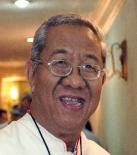The Catholic Bishops' Conference of the Philippines
The Official Website of
CBCP Online

On January 27, 1983, Pope John Paul II created the Apostolic Vicariate of San Jose de Mindoro comprising the province of Occidental Mindoro, and appointed the Most Reverend Vicente C. Manuel, SVD as the first Apostolic Vicar. He was ordained bishop on June 29, 1983.
Today the Apostolic Vicariate of San Jose de Mindoro covers a land area of 5,879 square kilometers with a population of 286,295 of which 79 per cent are Catholics. There are 13 parishes served by 10 diocesan and 20 SVD priests, 41 religious brothers and religious sisters. Among its Catholic institutions are the St. Joseph College Seminary, 6 Catholic schools, 1 hospital, the San Lorenzo Ruiz Formation Center and the Catholic Mangyan Educational Center. BEC's come up to 201 in the entire vicariate. There are 22 religious movements and organizations, and 10 Mangyan missions.
Following the Second Plenary Council of the Philippines' enlightened guidance and the vicariate's first twelve pioneering years, the vicariate's pastoral plan for the quinquennium 1995-1999 falls in line with its vision:
• One true Christian community, one in faith, worship and service in Christ; and the implementation of its five-year program: 1) the formation of Basic Ecclesial Communities, 2) rooted in the Word of God, 3) the formation of lay leaders, 4) the formation of lay ministries, and 5) bringing about integral human development—all these in accordance with its first bishop's motto: "At your Word."
The Apostolic Vicariate of San Jose, Occidental Mindoro was created on January 27, 1983. It comprises the civil province of Occidental Mindoro and its 11 municipalities. Its titular patron is St. Joseph the Worker whose feast is celebrated May 1 in the vicariate, and Our Lady of Fatima, its secondary patroness, whose feast is celebrated May 13. The Apostolic Vicariate of San Jose, Mindoro is a suffragan of the Archdiocese of Lipa.
The island of Mindoro lies south of the island of Luzon, directly south of Batangas Province, separated from it by the narrow Verde Island Passage. West of it is the Mindoro Straits and east of it the island of Marinduque. The entire island formed just one province until 1950 when it was politically subdivided into what are today Mindoro Occidental on the west, and Mindoro Oriental on the east.
The history of Occidental Mindoro is closely linked with that of its sister province, Oriental Mindoro. Spanish exploration of the island began as early as 1570. The Augustinians were the first to bring the faith, in 1574, followed by the Franciscans in 1578. Then the Jesuits came and stayed until 1667, by which time many Mangyans (aborigines of the island) were already settled in many places along the coast.
After the Jesuits left, the Recollects took over. This was the time of Muslim raids from the south, so not much is recorded as the settlements on the island were often abandoned. The towns of Mamburao (now the capital of Occidental Mindoro) and Balete became Muslim strongholds. Only towards the end of the Spanish regime did the Muslim attacks subside.
Under Spain the island of Mindoro was politically administered from Batangas until the 17th century, when it was made a corregimiento (equivalent to a province), with the island province of Marinduque under its administration.
Ecclesiastically Mindoro was part of the Manila diocese until the Diocese of Lipa was created in 1910 and Mindoro came under its jurisdiction. When the province of Mindoro was made an apostolic prefecture in 1936, it still remained under the jurisdiction of the Diocese of Lipa and had Bishop William Finneman, SVD at the helm of the prefecture. In 1951, following the political subdivision of the island province, the prefecture was elevated to an apostolic vicariate, the Apostolic Vicariate of Calapan.

Apostolic Vicariate of San Jose, Mindoro

